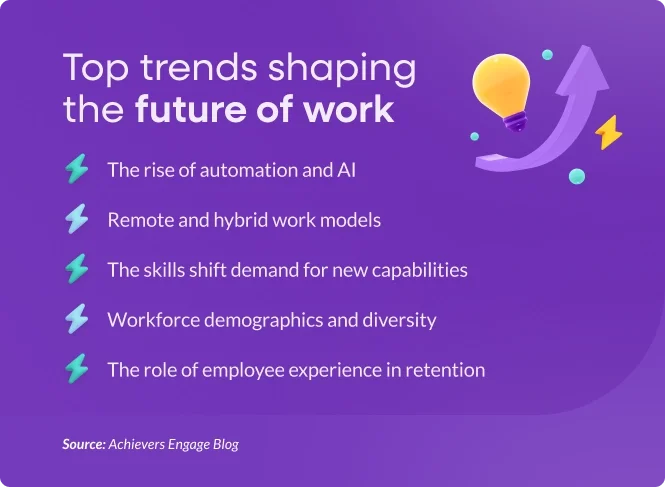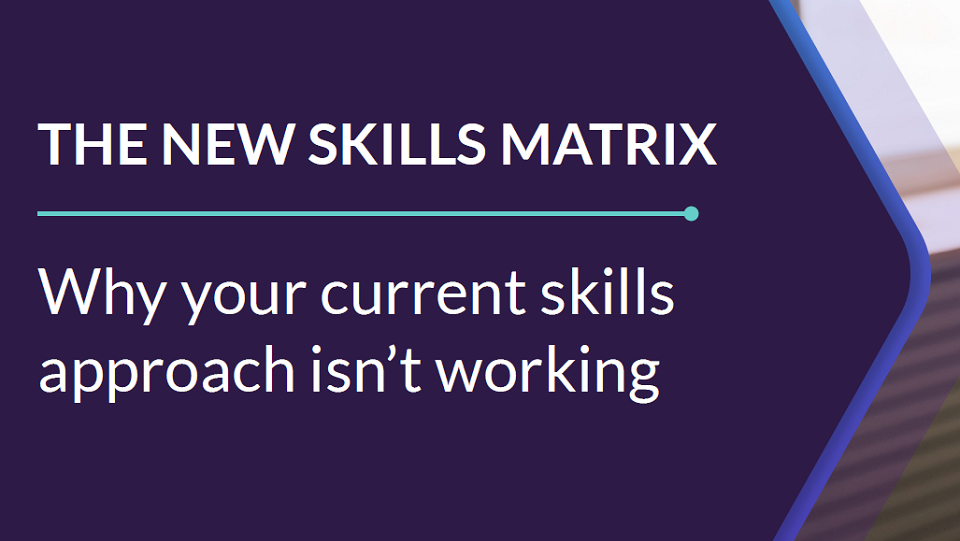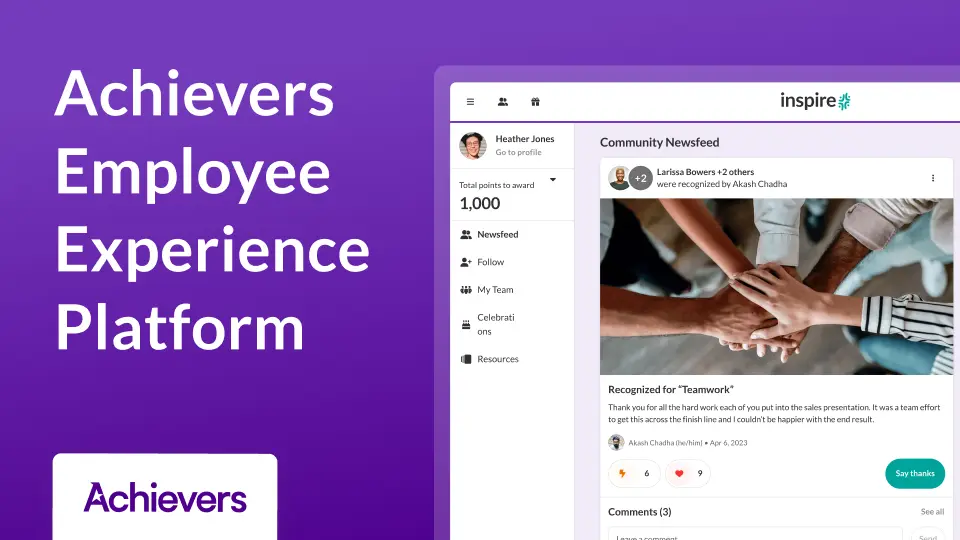Table of contents
The future of work isn’t just coming — it’s already here, shaking up office norms and rewriting the rulebook. Artificial intelligence (AI) is getting smarter, remote work is evolving, and technology is transforming jobs faster than ever.
For businesses and employees alike, staying ahead of these changes is essential for long-term success. From automation redefining job roles to the growing demand for workplace flexibility, the way we work is undergoing a massive shift.
So, what’s next? In this blog, we’ll explore five key trends shaping the future of work and how you can embrace them to stay ahead of the curve. Let’s dive in!
What is the future of work?
The future of work is defined by AI, automation, remote and hybrid work, and evolving employee expectations. As technology advances, businesses must adapt to digital transformation, flexible work models, and skills-based hiring. Employee experience is also shifting, with a greater focus on well-being, inclusion, and continuous learning. Companies that embrace innovation and foster a culture of agility will stay competitive in this new landscape.
From AI-powered tools to reimagined workplaces, the way we work is rapidly evolving. Staying ahead means leveraging technology, prioritizing employee engagement, and building a resilient workforce ready for the challenges of tomorrow.

The 5 key trends shaping the future of work
The workplace is evolving at a rapid pace, driven by advancements in technology, shifting employee expectations, and changing demographics. To stay competitive, businesses must embrace these transformations and adapt to new ways of working.
Here are five key trends shaping the future of work and what they mean for employees and organizations:
1. The rise of automation and AI
AI and automation are revolutionizing job roles by automating repetitive tasks, allowing employees to focus on strategic, high-value activities. A study by Amazon Web Services (AWS) reveals that 92% of organizations plan to adopt AI-powered solutions by 2028, anticipating a productivity boost of up to 49%.
This shift not only enhances operational efficiency but also necessitates the development of new skills among workforces. However, the rapid integration of AI in HR has raised concerns about job displacement. To mitigate these challenges, companies are investing in upskilling programs to prepare employees for AI-enhanced roles.
2. Remote and hybrid work models
The COVID-19 pandemic rapidly accelerated the shift to remote and hybrid work, transforming traditional workplace norms. A staggering 96% of employees believe remote or hybrid work improves their mental health, while studies show it has increased productivity by 13% compared to in-office setups. However, challenges remain, including feelings of isolation, reduced collaboration, and blurred work-life boundaries.
To counter these issues, companies are investing in digital collaboration tools, fostering virtual team engagement, and implementing flexible policies that balance autonomy with accountability. As hybrid work becomes the standard, businesses must continue refining strategies to enhance both employee well-being and organizational performance.
3. The skills shift demand for new capabilities
As industries evolve, the demand for digital and soft skills is skyrocketing. Proficiency in AI tools is now as critical as coding was for previous generations, shaping the future workforce. Employees must prioritize lifelong learning and upskilling to stay competitive in a rapidly changing job market.
Employers play a vital role by offering continuous learning opportunities, mentorship programs, and AI-driven training platforms. Creating a culture of adaptability not only helps bridge the skills gap but also boosts employee engagement, job satisfaction, and retention. Companies that invest in workforce development will thrive in an era defined by constant innovation.
4. Workforce demographics and diversity
The workforce is becoming more diverse, with multiple generations, backgrounds, and perspectives shaping the modern workplace. Embracing diversity, equity, and inclusion (DEI) is not just a moral obligation — it’s a competitive advantage. Studies show that companies prioritizing DEI initiatives experience higher financial performance, increased innovation, and improved employee satisfaction. A truly inclusive workplace attracts top talent, fosters collaboration, and enhances retention.
To build a resilient and dynamic workforce, organizations must implement unbiased recruitment, inclusive leadership training, and equitable career growth opportunities. A strong DEI strategy creates a culture where all employees feel valued, empowered, and motivated to succeed.
5. The role of employee experience in retention
Employee engagement, recognition, and well-being are crucial for retaining top talent. According to a PwC survey, 28% of workers are likely to switch employers in the next 12 months, with opportunities to learn new skills being a key factor in their decision.
Additionally, the survey found that 82% of workers who use generative AI daily expect it to make their work more efficient, indicating that integrating advanced technologies can enhance the employee experience. Organizations that invest in comprehensive employee experience strategies, including recognition programs and career development opportunities, are more likely to retain satisfied and productive employees.
Challenges in the future of work
As the workplace evolves, businesses and employees must navigate new challenges to remain competitive and successful. From the rise of AI to shifting work models, organizations must adapt to ensure long-term growth and employee well-being.
Here are just a few of the challenges you may face:
- Potential job displacement due to AI and automation: AI is streamlining operations and reducing repetitive tasks, but it also raises concerns about job displacement. Organizations must invest in upskilling and reskilling initiatives to help employees transition into emerging roles that leverage human creativity and problem-solving.
- Managing remote work culture and maintaining team cohesion: Hybrid and remote work models offer flexibility but can lead to disengagement and isolation. Companies must foster connection through digital collaboration tools, regular check-ins, and recognition programs to ensure employees remain engaged and productive.
- Addressing skills gaps and workforce reskilling: As technology advances, the demand for digital literacy, AI proficiency, and soft skills continues to grow. Organizations need to provide continuous learning opportunities and mentorship programs to bridge the skills gap and future-proof their workforce.
- Balancing productivity with employee well-being: The pressure to stay constantly connected can lead to burnout and disengagement. Businesses must support employee well-being through flexible work arrangements, mental health initiatives, and a culture of recognition to create a healthier, more sustainable work environment.
How businesses can adapt and prepare
As the workplace evolves, businesses must navigate significant challenges to create a sustainable and thriving workforce. Here are some of the key hurdles shaping the future of work:
Potential job displacement due to AI and automation
The rise of AI and automation is transforming industries, streamlining operations, and enhancing productivity. However, it also raises concerns about job displacement, particularly in roles that rely on repetitive or manual tasks. A report by McKinsey & Company estimates that activities accounting for up to 30% of hours currently worked across the U.S. economy could be automated by 2030. To mitigate this, companies must invest in reskilling initiatives and help employees develop competencies in AI, problem-solving, and strategic thinking.
Managing remote work culture and maintaining team cohesion
While remote and hybrid work offer flexibility, they also present challenges in building a strong company culture and maintaining team cohesion. Employees working from different locations may struggle with communication barriers, feelings of isolation, and disengagement. To overcome this, businesses should focus on virtual team-building activities, transparent communication, and digital collaboration tools that create a sense of belonging. Encouraging regular check-ins, clear goal setting, and an inclusive remote culture helps maintain alignment and engagement.
Addressing skills gaps and workforce reskilling
With rapid technological advancements, the skills gap continues to widen, increasing the demand for new digital and soft skills. The World Economic Forum’s Future of Jobs Report 2025 highlights that robust skill development efforts are essential to help workers thrive alongside evolving technology. Organizations must address this gap by prioritizing continuous learning programs, AI-driven training tools, and mentorship opportunities to equip employees for future roles. By fostering a culture of lifelong learning, businesses can close the skills gap, remain competitive, and ensure their workforce stays adaptable in an ever-changing job market.
Balancing productivity with employee well-being
As workloads increase and digital connectivity blurs the boundaries between work and personal life, burnout and stress have become major concerns. Companies need to implement mental health initiatives, flexible work policies, and recognition programs to support employee well-being. By fostering a healthy work-life balance, promoting regular breaks, and encouraging open conversations about mental health, organizations can sustain high performance while prioritizing employee happiness.
The future of work: what’s next?
The next decade will bring unprecedented changes to the workplace, driven by rapid advancements in AI, automation, and employee-centric innovations. AI-driven workplaces will become the norm, automating routine tasks and allowing employees to focus on strategic, high-value work. At the same time, hyper-personalized employee experiences — powered by data and predictive analytics — will tailor career paths, learning opportunities, and benefits to individual needs. Job roles will continue to evolve, requiring constant adaptation and upskilling.
HR technology will play a critical role in shaping the workplace of tomorrow, enabling companies to foster engagement, streamline operations, and enhance the employee experience. From AI-powered HR chatbots to advanced analytics for workforce planning, technology will help organizations stay agile in an increasingly digital world. To remain competitive, companies must embrace innovation, invest in upskilling, and leverage cutting-edge HR tech to create workplaces where employees thrive.
TIP: For more insights on the future of HR, check out our blog on HR trends for 2025.
Embrace the future of work with confidence
The workplace is evolving rapidly, shaped by AI, automation, remote work, shifting skill demands, workforce diversity, and the growing focus on employee experience. To stay ahead, businesses and employees must embrace change, adapt to new trends, and invest in continuous learning.
Solutions like Achievers empower organizations to navigate this transformation by boosting employee recognition, retention, and performance. By leveraging innovative tools, businesses can foster engagement, drive productivity, and build a thriving workforce for the future.
Stay informed, invest in the right technology, and embrace the future of work with confidence. The time to prepare is now!



